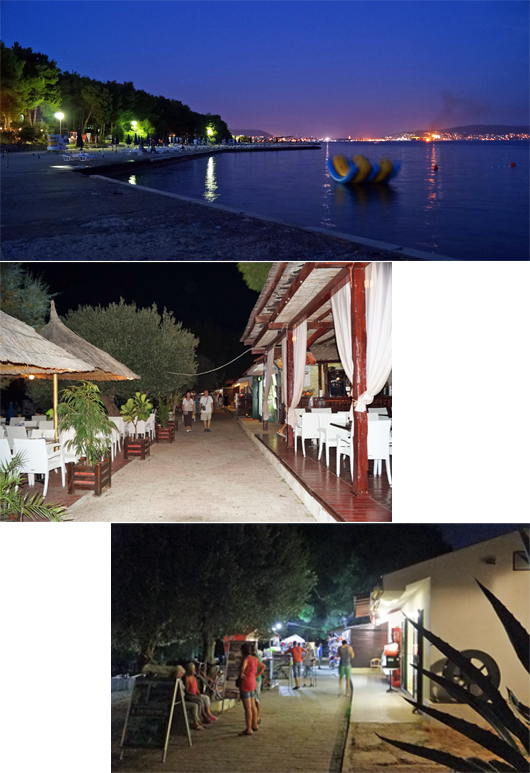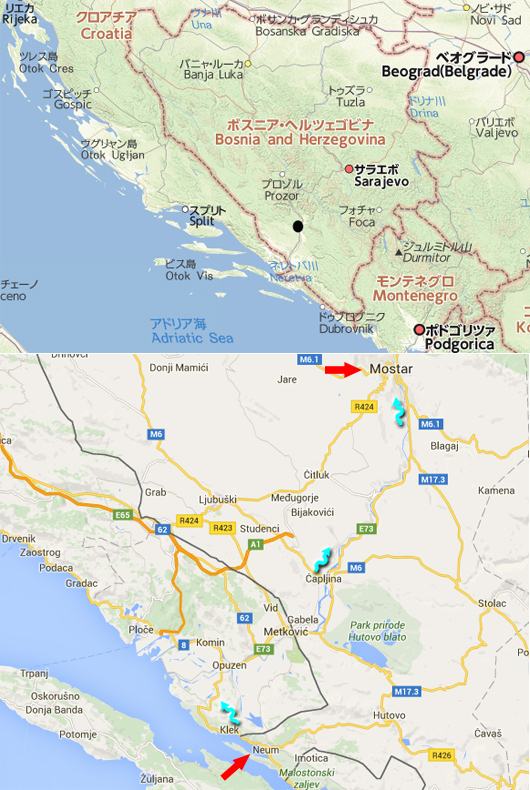クロアチア・スロベニアを巡って 22: 傷痕の町モスタル 1
< 1. Župa Svetog Petra
i Pavla is a church in Mostar >
< 1.モスタルの教会、Župa Svetog
Petra i Pavla >
Today, we go to the
intermountain town in Bosnia and Herzegovina.
I introduce the
scenery between coastal town Neum and the Mostar.
今日は、ボスニア・ヘルツェゴビナの山間の町に向かいます。
海沿いの町ネウムからモスタルまでの景観を紹介します。
< 2. Root maps >
< 2.地図 >
Upper map: It shows Bosnia and Herzegovina.
A black point is the Mostar.
Lower map: It shows the way to the Mostar from the Neum
that we stayed in.
Red arrows show the two towns,
and blue arrow shows the root.
The distance between the
Mostar and the Neum is about 60 km.
We left at 9 A.M. on
September 3, 2015, and arrived at 11 A.M.
It took much time,
because we went through two checkpoints on the border.
上の地図: ボスニア・ヘルツェゴビナを示す。
黒丸がモスタルです。
下の地図: ホテルのあるネウムからモスタルへの道を示す。
赤矢印が二つの町を示し、青矢印はそのルートを示す。
ネウムからモスタルまでは約60km。
2015年9月3日、9時に出発し11時に到着した。
時間がかかったのは、2箇所の国境検問所を通った為です。
About Mostar
1992-1995, Bosnia and
Herzegovina was involved into Yugoslav Wars.
At this time, we have known the capital
Sarajevo became the battlefield, and similar tragedy occurred in the Mostar,
too.
Race
of this nation consists of the most Muslims, subsequently a Croatian of the
Christian, and a Serbian of the Greek Orthodox Church.
And this nation
has a border with Croatia and Serbia.
By
this, this Muslims suffered damage by ethnic cleansing by a Serbian at the time
of Yugoslavia's collapse.
モスタルについて
1992~1995年、ボスニア・ヘルツェゴビナはユーゴ紛争に巻き込まれました。
この時、首都サラエボが戦場になったことはよく報道されたが、モスタルでも同様の悲劇が起こりました。
この国の民族は、イスラム教徒が一番多く、次いでキリスト教徒のクロアチア人、正教会のセルビア人で構成されている。
かつ、この国はクロアチアとセルビアと国境を接している。
このことにより、ユーゴスラビア崩壊時にイスラム教徒はセルビア人から民族浄化の被害を受けた。
< 3. Sceneries between
the Neum and downstream of Neretva >
< 3. ネウムからネレトヴァ川の下流まで >
Upper photo: People had been enjoying a marine vacation.
Central photo: As going through a mountain pass, I saw a monastery (?) on the hill.
Lower photo: The plains that spread out downstream of Neretva river.
上の写真: リゾートを楽しむ人々の姿が見える。
中央の写真: 峠を通過中、丘の上に修道院(?)が見えた。
下の写真: ネレトヴァ川の河口に広がる平野部。
< 4. We were coming
down to the plains >
< 4. 平野部に降りていく >
There are lots of dry mountains in this
area, but this place is filled with green.
乾燥した山間地が多い中にあって、ここは緑に溢れていた。
< 5. Towns along the
Neretva >
< 5. ネレトヴァ川沿いの街並み >
Upper photo: I saw a mosque for the first time in this
trip.
Graveyard
of Islam is seen on the left side.
Central
photo: Neretva.
Lower photo: Soccer seems popular.
上の写真: 今回の旅行で初めてモスクを見た。
左側に見えるのがイスラムの墓です。
中央の写真: ネレトヴァ川。
下の写真: サッカーが盛んなようです。
< 6. We go into the mountain valley >
< 6. いよいよ川沿いに山間地へと上って行く >
People are
growing grapes as hard as possible at the dry mountain area.
乾燥している山間地でも、人々はぶどうなどを精一杯栽培している。
< 7. Near Mostar >
< 7. モスタルに近づいた >
Central photo: Graveyard of Christianity system.
Lower
photo: We can look at innumerable
traces of big bullet on the outer wall of the apartment.
This
continues next time.
中央の写真: キリスト教系の墓地です。
下の写真: アパートの外壁に大きな銃弾の跡が無数に見える。
次回に続きます。













































